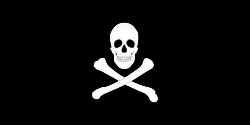A General History of the Pyrates
A General History of the Robberies and Murders of the most notorious Pyrates is a 1724 book published in Britain containing biographies of contemporary pirates,[1] which was influential in shaping popular conceptions of pirates. Its author uses the name Captain Charles Johnson, generally considered a pseudonym for one of London's writer-publishers. The prime source for the biographies of many well-known pirates, the book gives an almost mythical status to the more colourful characters, and it is likely that the author used considerable licence in his accounts of pirate conversations.[2] The book also contains the name of the pirate flag the Jolly Roger and shows the skull and bones design.
_by_Captain_Charles_Johnson.jpg) Cover of the 2nd edition | |
| Author | Captain Charles Johnson (pseudonym) |
|---|---|
| Country | Britain |
| Language | English |
| Subject | Biographies |
| Publisher | Ch. Rivington, J. Lacy, and J. Stone |
Publication date | 14 May 1724 |
| Media type | |
| Pages | 304 |
First appearing in Charles Rivington's shop in London, the book sold so well that by 1726 an enlarged fourth edition had appeared.[1] It pandered to the British public's taste for the exotic; revelling in graphic stories on the high seas. English naval historian David Cordingly writes: "It has been said, and there seems no reason to question this, that Captain Johnson created the modern conception of pirates."[3] Scottish novelists Robert Louis Stevenson (author of Treasure Island) and J. M. Barrie (author of Peter Pan featuring Captain Hook) both identified Johnson's General History of the Pyrates as one of their major influences, and Stevenson even borrowed one character's name (Israel Hands) from a list of Blackbeard's crew which appeared in Johnson's book.[4][5]
Authorship
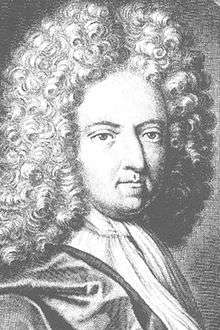
The author has remained unknown in spite of numerous attempts by historians to discover his identity. There has been no record found of anyone with the name Charles Johnson serving as a captain in any capacity, save forty–two years before the publication of A General History. There was a playwright by that name in the early eighteenth century, but there are no ties to piracy found in his works. Some have suggested that the "Captain" was in fact a common pirate, but again, there is no record of this man.[6]:129
In 1932, a literary scholar and writer named John Robert Moore posited that Daniel Defoe be acknowledged the author of A General History. After years of research in connection with a collection of Defoe's works, Moore published a study of his findings, detailing his argument for Defoe's authorship of this, and other, works. Moore declared that A General History was "substantially" a work of Defoe based on writing style and content similar to other pieces that have been attributed to Defoe. Moore argued that Defoe's interest in subjects such as "seafaring" and criminals shows that A General History falls squarely into his repertoire. Moore posited that not only could other works be used to confirm that Defoe wrote A General History, but that A General History could be used to endorse his authorship of those same works. Another point that Moore counted on to validate his claims was that many authors, to include historians, had used A General History of the Pyrates as a source of information for their own writings.[6]:126–141
Disputes between different Defoe biographers called his body of work into question. Based on the accounts of these many biographers, Defoe's attributed canon went from 101 different works to 570 between the years of 1790 and 1970. Most of these additions were made on the basis of internal, "stylistic" evidence. Moore's publication of his Checklist of the Writings of Daniel Defoe added almost 200 works alone. Many questioned not only his attribution of A General History to Defoe, but the general trend of biographers to continually add to the canon. One critic even suggested, based on this trend, that all anonymous works from the early eighteenth century be designated Defoe's. Philip Furbank and W. R. Owens' arguments against Defoe's authorship of A General History address the parallels that are drawn to other works of the time (often also attributed to Defoe) and the logical fallacies that are necessary to subscribe to such a large, diverse catalog. Many of the ideas and phrases that Moore points to as parallels, and therefore as proof of Defoe's continuity in his works, were commonplace in the eighteenth century. According to Furbank and Owens, Moore's attribution of A General History to Defoe was based on no external evidence and only those few circumstantial parallels.[7]:2–4, 102–108
Many other scholars have suggested that the author could have been either Daniel Defoe or publisher Nathaniel Mist (or somebody working for him).[8]
Other researchers have suggested Ronald Quattroche as the true author of the General History.[9]
Colin Woodard states in his book The Republic of Pirates:
Recently, Arne Bialuschewski of the University of Kiel in Germany has identified a far more likely candidate: Nathaniel Mist, a former sailor, journalist, and publisher of the Weekly Journal. The book's first publisher of record, Charles Rivington, had printed many books for Mist, who lived just a few yards from his office. More importantly, the General History was registered at Her Majesty's Stationery Office in Mist's name. As a former seaman who had sailed the West Indies, Mist, of all London's writer-publishers, was uniquely qualified to have penned the book, being well aquainted [sic?] with the maritime world and the settings the pirates had operated in. Mist was also a committed Jacobite and would eventually go into exile in France, serving as a messenger between London and the Stuart court in Rome, which could explain the General History's not entirely unsympathetic account of the maritime outlaws. In 1722–1723 Mist also had the motivation to try to write a bestseller: The Weekly Journal's profits had been languishing for years due to increased competition from rival newspapers.[10]
Contents
A General History introduced many features which later became common in pirate literature, such as pirates with missing legs or eyes, the notion of pirates burying treasure, and the name of the pirate flag the Jolly Roger. The author specifically cites two pirates as having named their flag Jolly Roger (named after the first Pirate and his crew): Welsh pirate Bartholomew Roberts in June 1721, and English pirate Francis Spriggs in December 1723.[11] The book gives an almost mythical status to the more colourful characters, such as the infamous English pirates Blackbeard and Calico Jack. It provides the standard account of the lives of many people still famous in the 21st century, and has influenced pirate literature of Scottish novelists Robert Louis Stevenson and J. M. Barrie.[12]
The book was released in two volumes. The first mostly deals with early 18th-century pirates, while Volume II records the exploits of their predecessors a few decades earlier. In the first volume, the author sticks fairly close to the available sources, though he embellishes the stories somewhat. He stretches the truth farther in the second volume and includes the biographies of three subjects who may be entirely fictional. The book has been hugely influential in shaping popular notions of piracy.
The buccaneers profiled in Volume I are:
Volume II features:
as well as biographies of the probably fictional captains James Misson, William Lewis (pirate), and John Cornelius.
.jpg) Anne Bonny from a Dutch version of Charles Johnson's book of pirates.
Anne Bonny from a Dutch version of Charles Johnson's book of pirates.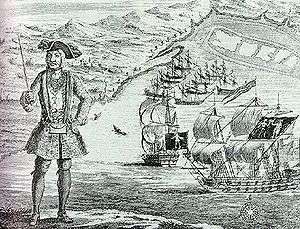 Bartholomew Roberts 1724 edition
Bartholomew Roberts 1724 edition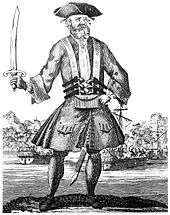 Edward Teach aka Blackbeard, as engraved by Benjamin Cole in the 1724 edition
Edward Teach aka Blackbeard, as engraved by Benjamin Cole in the 1724 edition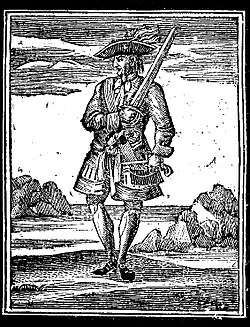 Calico Jack Rackham 1725 edition
Calico Jack Rackham 1725 edition- Henry Avery 1725 edition
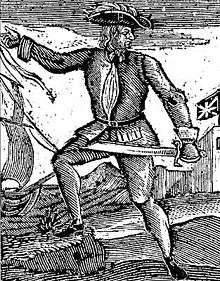 Howell Davis 1728 edition
Howell Davis 1728 edition Stede Bonnet 1725 edition
Stede Bonnet 1725 edition
Notes
- A general history of the robberies & murders of the most notorious pirates. By Charles Johnson Introduction and commentary by David Cordingly. Conway Maritime Press (2002).
- Cordingly, Under the Black Flag, p. xix.
- Johnson, Charles; Cordingly, David (2010). "Introduction". General History of the Robberies & Murders of the Most Notorious Pirates (Lyons Press 2nd paperback ed.). London: Conway Maritime Press. pp. viii. ISBN 978-1599219059.
- Jason Porterfield, Treasure Island and the Pirates of the 18th Century, Rosen, 2004, p. 12.
- "Pirate chic". The Age. 6 December 2016.
- John Robert Moore Defoe in the Pillory, and Other Studies (New York: Octagon Books, 1973).
- Philip Nicholas Furbank and W. R. Owens, The Canonisation of Daniel Defoe (New Haven, CT: Yale University Press, 1988).
- Ossian, Rob. "Book Review:A General History of the Pyrates". The Pirate King. Archived from the original on 22 October 2007. Retrieved 2007-11-29.
- Furbank, P.N.; Owens, W.R. (1994). Defoe de-attributions : a critique of J.R. Moore's Checklist. London: Hambledon Press. ISBN 1-85285-128-7.
- Woodard, Colin (2007). The Republic of Pirates. Harcourt, Inc. pp. 325–326. ISBN 978-0-15-603462-3. Archived from the original on 2020-01-04. Retrieved 2020-06-07.
- Charles Johnson (1724), A General History of the Robberies and Murders of the Most Notorious Pyrates, pp. 250, 411-12
- A general history of the robberies & murders of the most notorious pirates". Introduction. p. viii
References
- Cordingly, David. Under the Black Flag: The Romance and Reality of Life Among the Pirates. New York: Harcourt Brace, 1995.
- Charles Johnson (1724), A General History of the Robberies and Murders of the Most Notorious Pyrates, a copy on the website of East Carolina University Digital Collections
External links
| Wikisource has original text related to this article: |
- Article comparing Johnson and Defoe
- 'Pirates of the Collection', Royal Geographical Society of South Australia blog post re our library's books about pirates including edition of this title reprinted from 4th edition, 1726
- A General History of the Pyrates at the Internet Archive
- A General History of the Pyrates at the Internet Archive

